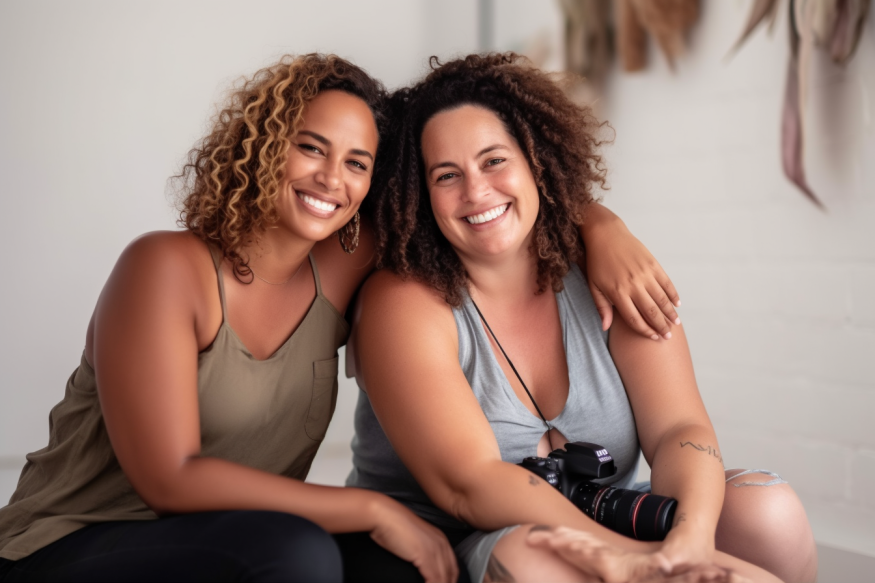How To Handle A Difficult Boudoir Client
- Mike Cassidy

- Jun 9, 2023
- 14 min read

It will happen-- it's inevitable. If you haven't run in to a difficult boudoir client yet, you just haven't done enough sessions.
In general, I find boudoir clients to be a rather amiable bunch. Other than the typical questions about the boudoir process, which is pretty standard, I rarely run into any customer issues. There will, however, be stressed-out brides, last minute anniversary gifts, and the occasional client who somehow expected something, well, a bit different. Not handling these clients properly from the start can certainly lead to some difficulties.
Are you ready?
Much of avoiding client issues starts with have good processes in place including: Your understanding of the consultative sales process, having a good workflow, and being skilled in the management of high end customers.
Many photographers fail at this point due to their own lack of awareness. People often don't understand there is a lot more to running a photography business than just picking up a camera. In actuality, that's just a small part of the job. Think of it this way: If you could make amazing hamburgers and decided you'd open a restaurant, do you think grilling those amazing flame grilled burgers is the only thing necessary for success? Heck no. There is food ordering, payroll, management of your front end employees, scheduling, etc. -- The list goes on and on. If you open a restaurant, being able to grill a great burger isn't enough, alone, for success.
Likewise, in photography, there are other necessary skills that need mastering to help your business grow. If you make up over the hump and start finding some success in a photography business, you realize there are lot of these such skills needed to survive, and bring your business to a top level. It's super hard to be an expert in all of them! That's why success is so hard.
This article is going to focus on a few of the more customer oriented aspects of running your photography business.

Understanding the sales process
Boudoir takes some sales skills. Despite what you think, there's probably a lot you don't know about the sales process. This, in itself can be an overwhelming thing to learn. There are dozens of sales "gurus," and "sales systems" out there. Which one do you follow? Which one is the best? Well, that's a topic for another blog post (or book of posts!) which I am not going to get into here, but nevertheless, educating yourself about the sales process, particularly one that deals with high end sales, is a good investment.
People buy emotionally and process intellectually.
The whole boudoir funnel process needs to be handled a bit more differently, than say a transaction for a pair of boots at your local DSW. There are fewer boudoir prospects out there, and each one has a high potential value, so a lot of care has to be put into each prospect, and more time has to be invested in to each of these prospects to ensure a smooth process.
Remember: Boudoir is expensive! As with any expensive purchases, people are much more deliberate in the process of making sure of what they will be getting in exchange for their hard earned dollar. Because boudoir is expensive, people want to be sure they are making the right decision, so it's generally not going to be a quick spur of the moment decision on their part.
Success starts in understanding the sales process. Unlike what you've most likely ready in a snappy blog post about selling photography, people don't buy features. Nobody cares you've been doing photography for ten years. Nobody cares you've won a local photography award. It just doesn't matter.
People may take weeks to commit to a photographer. That's normal in this day and age of point-and-click shopping. There is a world of photographers, reviews, and sample photos that people will scrutinize in effort to compute the best choice for them.
There's a certain group of people who get bogged down in the whole selection process, known as "analysis paralysis." The perfect modern example of this is buying something as mundane as a wastebasket on Amazon. OMG there are hundreds...AND ITS ONLY A FREAKING BATHROOM TRASH BIN. Even for a $18 item, don't be surprised that there are people who will take days and days...reading endless reviews for trash cans. Trash can reviews! It really happens! (I wish I had that kind of free time.)
If the stars align, and you do manage to book that person as a client a whole new world of potential issues await.
Some potential issues:
1. Unrealistic Deadlines.
Sometimes you'll have a last minute bride (although thankfully most brides seem to be great planners!) or a last minute anniversary request. As you know, boudoir is not a great last minute item. It can take a while to schedule a session, then there is post session time needed for editing, book creation time, etc. Clients aren't necessarily immediately aware of all the time involved in producing their gift.
How to avoid these issues: Setting proper expectations when you are booking your client. Explaining to them the process and the time involved so they understand your work flow and your typical turn around time. Explain to the the time involved in book binding. Your realistic estimate for editing time.
If you are not going to be able to make a date-- let the client know up front.
2. Unrealistic Expectations
Boudoir photographers like to sell an experience. They talk about all of these lofty ideas such as offering "empowerment" and "life improving" through their services. These are great goals of a session, but are you actually delivering these intangibles?
Boudoir photography is about creating beauty. The one thing you may not see coming is how others may see themselves. What do you do when client calls upset because she thinks she looks so overweight in all her photos?
I once had a client who was probably in her 70s (probably her mid-70s) who walked in on her session day and handed me a stack of magazines. She pointed to a cover of one of the magazines, which was a photo of a 20 year old Italian model sitting in a chair, and said "I want pictures that look like this..." Needless to say after the session she told me she was unhappy because she didn't look like the 20 year old model on the magazine cover.
This is real, and this is something that you will bump in to... it's just a matter of time.
How to avoid these issues: Managing and avoiding unrealistic expectations starts with clear communication right from the initial consultation. A comprehensive pre-session consultation is an opportunity to set the scene for what the client should expect. Here, you can explain your style, discuss what they hope to achieve from their session, and guide them towards realistic outcomes. Use your portfolio as a visual guide to set expectations about your style and the results they can anticipate. One important aspect to tackle head-on is the concept of photo editing. Make it clear that while you strive to present every client at their absolute best, Photoshop is a tool for enhancement, not total transformation. By creating this open line of communication from the beginning, you're setting the groundwork for realistic expectations, making for a smoother and more satisfying boudoir experience for your client.
3. Unrealistic Demands.
Sometimes there may be a situation with something seemingly minor, that you may never have even considered a potential issue. You may be great with your clients, and think you have covered everything. Then you session starts, and your client makes an an innocent request. Every time you take a shot, she asks to see it. Not only that, she is critiquing your work, right in front of you.
Photography is very subjective and everyone has their own unique expectations.
How to avoid these issues: Avoiding unrealistic client demands starts well before the session, during the consultation phase. This is where you establish the ground rules for the session. Make sure to explain your workflow and process in detail, and ensure your client understands how the session will proceed. Be explicit about what you are and are not able to accommodate, whether that relates to session duration, number of outfit changes, or the extent of post-production edits. By setting clear boundaries and expectations from the start, you make it less likely that a client will make demands that go beyond what is reasonable or feasible. In essence, being proactive about setting realistic expectations can effectively curb unrealistic demands. It's all about clarity, communication, and setting the right expectations from the start.

Learn how to handle client expectations.
Understanding and managing client expectations is an essential part of running a successful boudoir photography business. Here are some steps to help you navigate this complex, yet crucial, process.
1. Open Communication
One of the best ways to handle client expectations is through open, honest, and continuous communication. From the first interaction with a client, be upfront about what they should expect throughout the process, from the initial consultation to the final delivery of their photos.
2. Understand Their Vision
As a photographer, your primary role is to bring your client's vision to life. Take the time to understand their goals for the session. Ask for references or ideas they might have in mind. This will help you set the tone for the shoot and will reduce the chance of misunderstandings or dissatisfaction.
3. Set Clear Expectations
It's important to make sure your client understands what can realistically be achieved in a session. If a client is hoping to recreate a photoshoot of a supermodel with an army of makeup artists and stylists, it's your responsibility to make clear what is and isn't possible. Make sure they understand that while you'll do your best to make them look and feel incredible, the photos will ultimately be a reflection of their own unique beauty.
4. Educate Your Clients
Provide clients with information on how to prepare for their session, what to expect during the shoot, and a timeline for when they will receive their final images. This gives them an understanding of the entire process, reducing potential stress or confusion.
5. Manage Expectations Throughout the Process
Your job doesn't end after the initial consultation. Continually reassess and manage expectations as you go through the process. Check-in with your clients regularly, providing updates and reassurances.
6. Deliver on Your Promises
Finally, nothing manages expectations better than delivering high-quality work on time. Make sure you follow through on your promises. If anything unexpected arises that may affect the delivery, be sure to communicate this to your client as soon as possible, along with a plan for how you will handle it.
Handling client expectations effectively can lead to greater client satisfaction, repeat business, and even referrals. It's a delicate art, but by keeping the lines of communication open, setting clear and realistic expectations, and delivering on your promises, you'll build a reputation for being a reliable and professional boudoir photographer.

Connect With Your Clients
Connecting with clients in the realm of boudoir photography transcends merely understanding their vision and handling their expectations; it is about forging a genuine, meaningful relationship that places their comfort and confidence at the forefront.
First and foremost, connecting with your clients requires empathy. Remember, for many, a boudoir session can feel incredibly intimate and somewhat vulnerable. It's essential to reassure them that their feelings are normal and that you are there to guide them through the process. Proving that you genuinely care about their concerns and their aspirations can set the stage for a positive and meaningful interaction.
Understanding their motivations behind the photoshoot is another crucial step. Are they looking to celebrate a personal milestone, boost their self-confidence, or perhaps gift the images to a loved one? Knowing their 'why' allows you to tailor the session accordingly, and in doing so, provide an experience that goes beyond their expectations.
Active listening plays a pivotal role in building a connection with your clients. When they speak about their preferences, reservations, or expectations, listen attentively, and respond thoughtfully. This engagement not only helps you deliver better photographs but also demonstrates respect for their feelings and ideas.
Similarly, transparency fosters a strong connection with clients. Be clear about what the process involves - from the pre-shoot preparations to the post-shoot delivery timeline. This openness reduces potential misunderstandings and instills confidence in your clients. It also demonstrates your reliability and commitment to providing a satisfactory experience.
In this intimate genre of photography, respect for boundaries is paramount. The boudoir session is a space of trust and confidentiality, and respecting this can significantly boost your connection with clients. Provide clear guidance on posing while always ensuring that your client is comfortable and feels in control of the situation.
Finally, infuse personality into your interactions. Genuine laughter and light-hearted conversation can help to break the ice and allow your clients to relax. It's the personal touches, after all, that often transform a good experience into a great one.
In essence, connecting with your clients in boudoir photography involves creating an environment of trust, respect, and empathy. This process is less about the technicalities of photography and more about fostering a sense of comfort and confidence in your clients. By listening attentively, understanding their motivations, respecting their boundaries, and adding your personal touch, you can create an experience that resonates on a personal level and ensures a memorable boudoir session.

Offer A Solution - Be Solution Oriented
Being solution-oriented is pivotal in the realm of boudoir photography. The personal nature of this genre means that problems or unexpected situations are inevitable, and how they're approached can be the defining factor in a client's overall experience.
The first step in adopting a solution-oriented approach is anticipating potential challenges. These could range from last-minute schedule changes to unexpected personal insecurities emerging during the shoot. By preparing for these, you position yourself to swiftly provide solutions and keep the experience smooth and positive for your clients.
Creating an environment where clients feel comfortable expressing their concerns is key. By fostering open communication, your clients will be more likely to share any issues they encounter, providing you with the opportunity to address them promptly. In such instances, it's crucial to respond empathetically, validating their feelings and showing understanding before presenting a solution.
Once a problem is identified, adopt a proactive approach. Start by fully understanding the issue, asking for clarifications if needed, and then brainstorming potential solutions. The goal here is not just to remedy the situation, but to do so in a way that demonstrates your commitment to your client's satisfaction. The solution may not always be obvious, and that's okay. Sometimes, it might be necessary to think creatively or even seek advice from others in your field.
When presenting the solution, do so with positivity and confidence. Clients may often be stressed or anxious when they encounter a problem, and your attitude can greatly influence their reaction. If you present your solution with assurance and a positive outlook, your clients are more likely to accept it and feel reassured.
After implementing your solution, follow-up is key. Check in with your clients to ensure the issue has been fully resolved and that they are satisfied with how it was handled. This demonstrates that you value their feedback and are committed to their satisfaction, which in turn strengthens their trust and confidence in you.
Ultimately, adopting a solution-oriented mindset requires agility, empathy, and a commitment to client satisfaction. Problems are not roadblocks, but rather opportunities for you to demonstrate your professionalism and dedication. By anticipating potential issues, encouraging open communication, proactively addressing problems, presenting solutions positively, and following up, you're well on your way to providing a superior, solution-oriented boudoir photography experience.

Make a mistake? Own it.
In the business of boudoir photography, like in any other venture, errors can occur. The lens of perfection, as enticing as it may seem, is realistically unattainable. What sets a professional apart, however, is not an impeccable record of flawlessness, but the ability to own up to mistakes when they do happen.
Acknowledging errors does not dilute your professionalism; rather, it enhances it. It shows you value integrity above the facade of perfection, a quality clients appreciate. This practice also builds trust. When you demonstrate the courage to admit a mistake, it solidifies client trust in your honesty and transparency, qualities that are particularly important in a field as intimate as boudoir photography.
Owning your mistakes also means seeking resolution, which necessitates a proactive and client-centered approach. This begins with an apology, one that is sincere and devoid of justifications. An apology shows empathy towards the client's experience, acknowledging that the service did not meet the standard they expected.
However, an apology should be just the starting point. Following the apology, it's important to offer a concrete plan to rectify the situation. This demonstrates your commitment to making things right and your dedication to the client's satisfaction.
This process should be tailored to the unique circumstances of the mistake. If there was a scheduling mix-up, you might propose a rescheduling at the client's convenience along with an additional service as a token of goodwill. If the issue was with the quality of the images, you might offer a reshoot or a complimentary session in the future. The key is to put the client's needs and satisfaction at the forefront.
Once you've proposed a resolution, it's crucial to follow through. Make sure the proposed solution is carried out promptly and efficiently. This not only rectifies the current issue but also reassures your client about your reliability and professionalism.
Lastly, take each mistake as a learning opportunity. Every situation you navigate through enhances your experience, and every error presents a chance to refine your processes and services. Use these instances as tools to improve, to perfect your skills, and to enhance the experience you provide for your clients.
Owning your mistakes, therefore, becomes a testament to your growth, integrity, and dedication to client satisfaction. It's not about never making a mistake; it's about how you handle it when you do. And with the right approach, you can turn a moment of error into an opportunity for growth, learning, and strengthened client relationships.

Building Long-Term Relationships
The art of boudoir photography isn't just about a one-time transaction, a single snapshot of a moment in time. It's about forging connections, building trust, and fostering enduring relationships. Each client session can potentially be the beginning of a long-lasting professional relationship that spans years, or even decades.
Post-session follow-ups are a first step in maintaining this connection. Reach out to clients after the shoot, inquire about their experience, and ask for feedback. This demonstrates your commitment to their satisfaction and your willingness to continually improve. These follow-ups can also provide opportunities to introduce future services or promotions that could be of interest to your clients.
Remembering special occasions like birthdays or anniversaries is another effective way to maintain relationships. A simple message acknowledging these milestones shows your clients that you value them as individuals, not just as customers. Even better, offer them a small token or discount on these occasions as a gesture of goodwill.
Offering loyalty rewards or incentives for repeat business can also be beneficial. For instance, discounts on future sessions, referral bonuses, or exclusive offers can encourage clients to maintain their relationship with you. Always ensure these programs are tailored to the needs and preferences of your clientele.
In addition to these strategies, regular communication, such as newsletters or social media updates, can keep you fresh in your clients' minds. Use these platforms to share new services, offer useful tips, or showcase recent work. This not only keeps clients informed, but also gives them a sense of being part of your professional journey.
Building long-term relationships, however, extends beyond just customer retention tactics. It's about creating a unique client experience that begins with the first consultation and continues long after the session. It's about being a source of positivity, empowerment, and confidence in their lives.
This level of connection and relationship-building doesn't happen overnight. It takes time, genuine care, and the determination to go beyond the expected. But the rewards, both in terms of client satisfaction and business success, are well worth the effort. By focusing on building these long-term relationships, you can transform one-time clients into lifelong advocates for your business.

Conclusion
Navigating through the complexities of the boudoir photography business can sometimes feel like trying to solve a multi-layered puzzle. Every interaction, every decision, has an impact on the final picture. From understanding and navigating client expectations, connecting with clients, offering solutions, owning your mistakes, to building long-term relationships – each piece adds depth and dimension to the grand tableau of your business.
The heart of it all is a simple yet profound concept: exceptional client service. In this intimate niche of photography, your success hinges on the quality of experiences you provide. Going above and beyond in every aspect, putting the client at the center of your operations, and consistently striving for excellence are what set you apart. The quality of your work may draw clients in, but the quality of their experience with you will keep them coming back.
Running a successful business is not merely about mastering the technical aspects of photography. Just as important, if not more so, is mastering the art of client service. The nuances of handling various client scenarios, the tact involved in dealing with unrealistic expectations, and the grace needed to own your mistakes - these are skills just as crucial as knowing your way around a camera.
Finally, remember that business growth doesn't always mean getting new clients - often, it means getting the most out of the ones you already have. Nurturing existing relationships is a vital aspect of business development. The client who feels valued and appreciated is the client who returns, who refers others, who becomes a lifelong advocate for your business.
Building a successful photography business is an ongoing process. It's a journey that requires dedication, patience, and a willingness to continuously learn and adapt. But with these skills and attitudes in your toolkit, you are well equipped to create a thriving business, one that not only fulfills you professionally but also makes a positive impact on the lives of your clients. So, embrace the journey, cherish the experiences, and keep focusing on what truly matters - providing an exceptional service and a beautiful experience.



